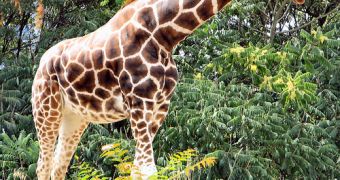There's nothing taller on Earth: large giraffe bulls can be 6 m (20 ft) tall, and weigh up to 1.5 tonnes! If you look at giraffes across the African savannas, you'll see that they all look the same. With one exception: the shape and color of their spots. A new DNA research published in "BMC Biology" shows that there is more than that: those different models betray, in fact, different giraffe species. At least six.
By now, giraffes are classified into one species with various subspecies.
"Using molecular techniques we found that giraffes can be classified into six groups that are reproductively isolated and not interbreeding", lead author David Brown, a geneticist at the University of California Los Angeles (UCLA), told BBC News. "The results were a surprise because although the giraffes look different, if you put them in zoos, they breed freely."
DNA showed that two giraffe groups inhabiting close areas to each other - the reticulated giraffe (Giraffa camelopardalis reticulata) in North Kenya, with beautiful reddish round spots, and the Maasai giraffe (Giraffa camelopardalis tippelskirchi) in South Kenya - split from each other 0.5 to 1.5 million years ago.
Geographic isolation is discarded, as giraffes are very mobile, having territories of over several hundred square km and making movements of 50-300km (30-170 miles), so that closely located populations are not isolated.
"There are no rivers or forests to prevent breeding, but some evolutionary process is keeping the two groups reproductively separated", said Brown.
The team supposes that the differentiation could have been triggered by different ecological niches (adaptation to different types of vegetation) or sexual selection.
The new research is a warning signal for those involved in conservation.
"Lumping all giraffes into one species obscures the reality that some kinds of giraffe are on the brink. Some of these populations number only a few hundred individuals and need immediate protection", said Brown.
In the last 10 years, the giraffes' number plummeted by 30%, the overall number being now less than 100,000. Extremely menaced are the Nigerian giraffe (Giraffa camelopardalis peralta), with just 160 individuals in West and Central Africa, and the Rothschild giraffe (Giraffa camelopardalis rothschildi), with a few hundred in some protected areas in Kenya and in Murchison Falls National Park, Uganda.
The International Giraffe Working Group (IGWG) is reassessing the status of the giraffe and will report this to the IUCN Red List of threatened and endangered species.

 14 DAY TRIAL //
14 DAY TRIAL //